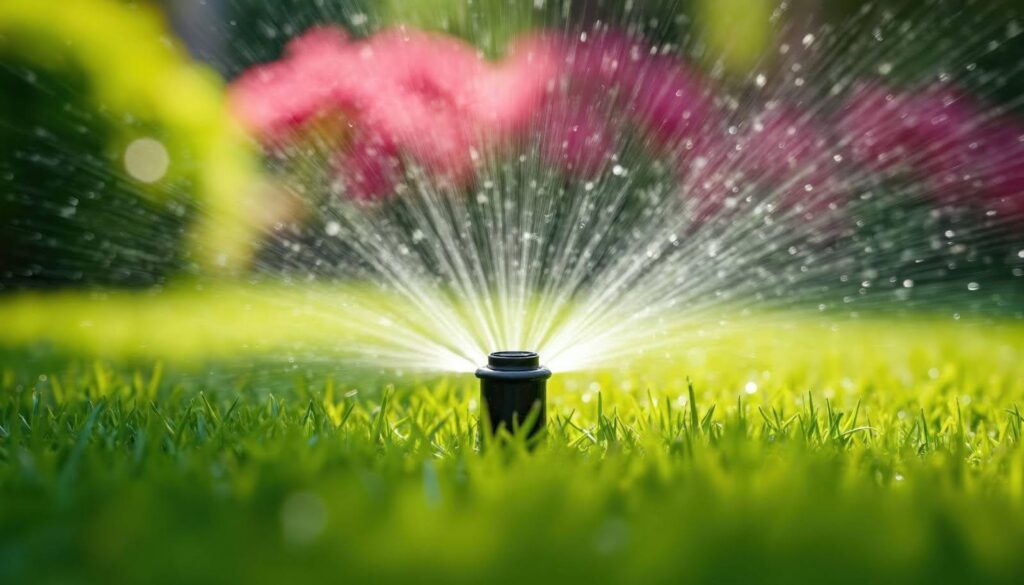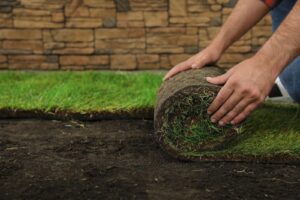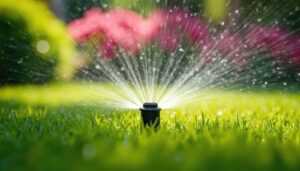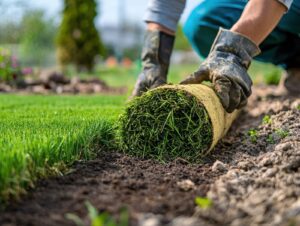Watering plays a critical role in helping new sod take root and thrive. Even the highest-quality turf will struggle to establish itself without the right hydration routine, resulting in patchy growth, browning, or total failure.
In this blog, we’ll walk through everything you need to know about watering new sod. You’ll learn a week-by-week timeline, daily watering routines, how to adjust for weather and soil type, and common mistakes to avoid.
Whether you’ve already installed your sod or plan to do so soon, this guide gives you the tools to keep your lawn vibrant and strong from day one.
Why watering new sod matters
New sod needs steady moisture to develop strong roots. During the first few weeks after installation, the grass draws all its hydration from the thin layer of soil it arrives with. Until the roots grow into the native soil below, watering provides the only way to keep the sod alive and thriving.
Without enough water, sod dries out quickly. The grass blades wilt, the soil hardens, and the roots shrivel. On the other hand, overwatering drowns the roots, limits oxygen flow, and encourages fungal disease. Both extremes delay rooting and weaken the lawn’s foundation.
Consistent, balanced watering helps sod integrate with the existing soil. It softens the ground, encourages downward root growth, and supports early nutrient uptake. By maintaining ideal moisture levels, you give your sod the best chance to anchor deeply, resist stress, and grow into a healthy, lasting lawn.
Week-by-week watering schedule
Establishing a healthy lawn begins with a carefully timed watering routine.
Week 1: Frequent, shallow watering
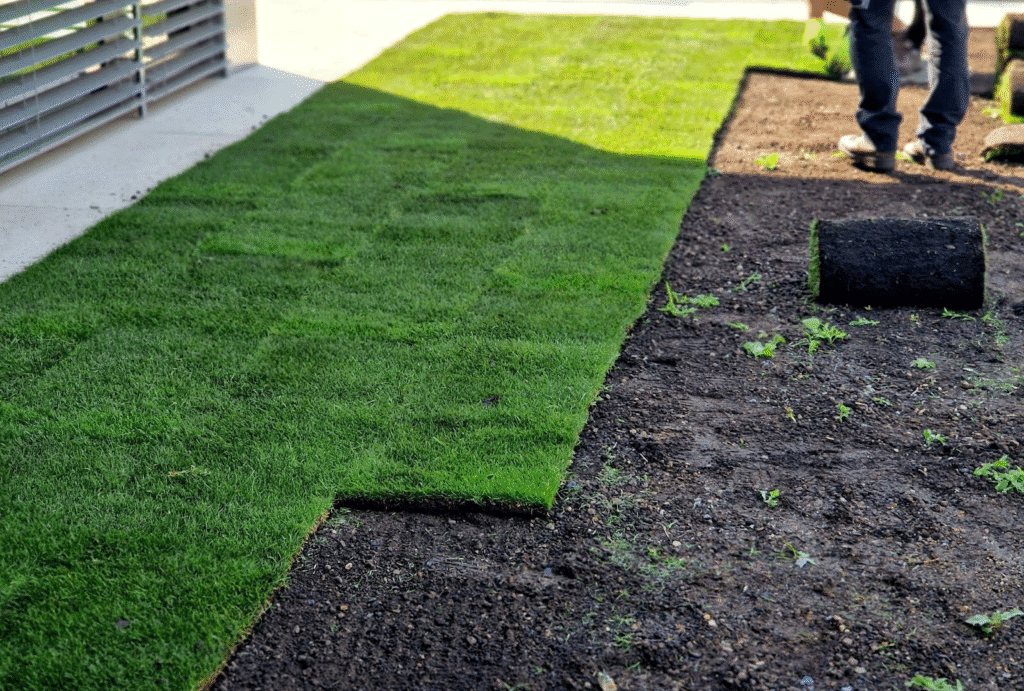
During the first week after sod installation, keep the sod and topsoil consistently moist to encourage initial root contact. Water the lawn two to four times daily for five to 10 minutes each session.
Focus on early morning and late afternoon watering, with a midday session if temperatures rise. Avoid letting the sod dry out, as this slows root development and increases stress.
Week 2: Transition to deeper watering
In the second week, reduce the number of watering sessions to once or twice daily and increase the duration to 10 to 15 minutes per session. Begin encouraging the roots to grow into the soil beneath.
Check for signs of root establishment by gently tugging at the sod. If it resists movement, rooting has begun. Adjust your schedule based on weather conditions and soil moisture.
Weeks 3–4: Deep, less frequent watering
By weeks three and four, shift to deeper watering every one to two days. Each session should last 20 to 30 minutes. Allow the surface layer of soil to begin drying out between sessions to stimulate deeper root growth. Continue monitoring root resistance to track progress and ensure your sod remains healthy.
Week 5 and beyond: Regular lawn watering schedule
Once the sod has rooted firmly into the soil, follow a standard watering routine based on your grass type and climate. Water the lawn two to three times per week, focusing on deep soaking rather than light surface watering. This promotes a strong, drought-resistant root system that supports long-term lawn health.
Factors that affect watering frequency
Watering new sod requires more than sticking to a set schedule. Several environmental and site-specific conditions determine how often you need to irrigate. Understanding these factors helps you create a routine that promotes deep rooting and long-term lawn health.
Climate and season
Local weather plays a major role in how quickly your sod loses moisture. Hot, dry climates require frequent watering, especially in the early weeks after installation. During cooler seasons or in humid environments, the soil retains moisture longer.
Adjust your watering frequency to match daily temperatures, rainfall, and evaporation rates. Pay close attention during heatwaves or droughts, when new sod dries out faster and needs more support.
Soil type
Different soils absorb and retain water at varying rates. Sandy soil drains quickly, which means you may need shorter, more frequent watering sessions. Clay-heavy soil holds moisture longer but drains slowly, increasing the risk of overwatering or root rot if you water too often. Loamy soil provides the best balance.
Before you create a watering plan, assess your soil’s texture so you deliver the right amount of water without drowning or drying out your sod.
Sod variety
Some grass types grow faster and root more aggressively than others. Tall fescue develops deeper roots quickly and tolerates light drought once established, while Kentucky bluegrass starts slowly and needs consistent moisture during early growth.
Know your sod variety’s rooting timeline to match its needs with the right watering routine. Fast-rooting varieties may transition to deeper, less frequent watering sooner than slower-growing options.
Sun exposure and wind patterns
Lawns exposed to full sun throughout the day dry out faster than shaded areas. Similarly, yards with constant wind lose surface moisture quickly, even when temperatures remain moderate. Track how much sunlight and airflow your yard receives to prevent dehydration in exposed areas.
If certain sections of your lawn receive extra sun or wind, increase watering frequency or duration in those zones to ensure uniform growth.
How to know if you’re watering enough
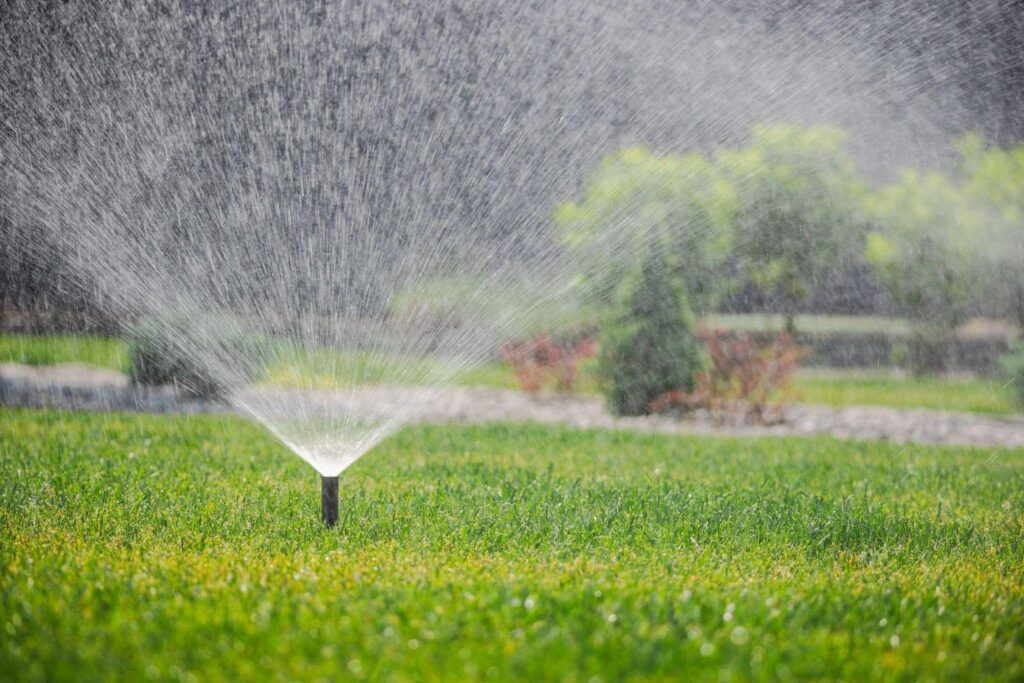
Consistent moisture helps sod establish strong roots, but overwatering or underwatering delays that process. Use a few simple methods to gauge your progress.
Perform a tug test
Lightly pull on a corner of a sod strip. If it resists, roots have begun anchoring into the soil. If it lifts easily, the sod still needs time and consistent moisture to establish.
Look for visual signs
Healthy sod appears vibrant and green, with edges that lie flat. If you see curling, browning, or patchy spots, check underneath. Moist soil two to three inches below the surface indicates proper watering. Dry, compacted soil means you need to adjust your routine.
Test with a screwdriver
Push a screwdriver or soil probe into the ground. If it enters easily up to six inches, your watering penetrates deep enough — resistance or shallow depth signals that water isn’t reaching the root zone.
These simple checks help you fine-tune your watering schedule and support a healthy lawn.
Trust Monarch Sod for a thriving lawn
Make sure your lawn starts with the best foundation, and choose high-quality, locally grown sod from Monarch Sod. We grow our sod in Utah for Utah soil, ensuring better moisture retention, stronger roots, and faster establishment. Whether you’re installing a new lawn or refreshing bare spots, our team delivers fresh-cut sod and expert support to help every blade thrive.
Contact Monarch Sod today to get premium sod, timely delivery, and guidance that guarantees greener results from the ground up.









